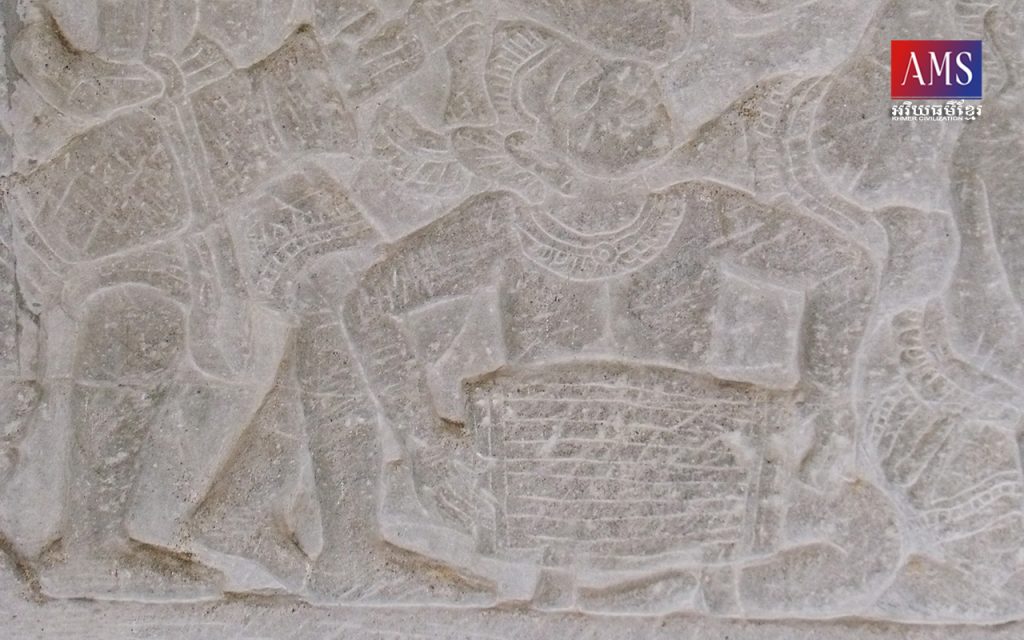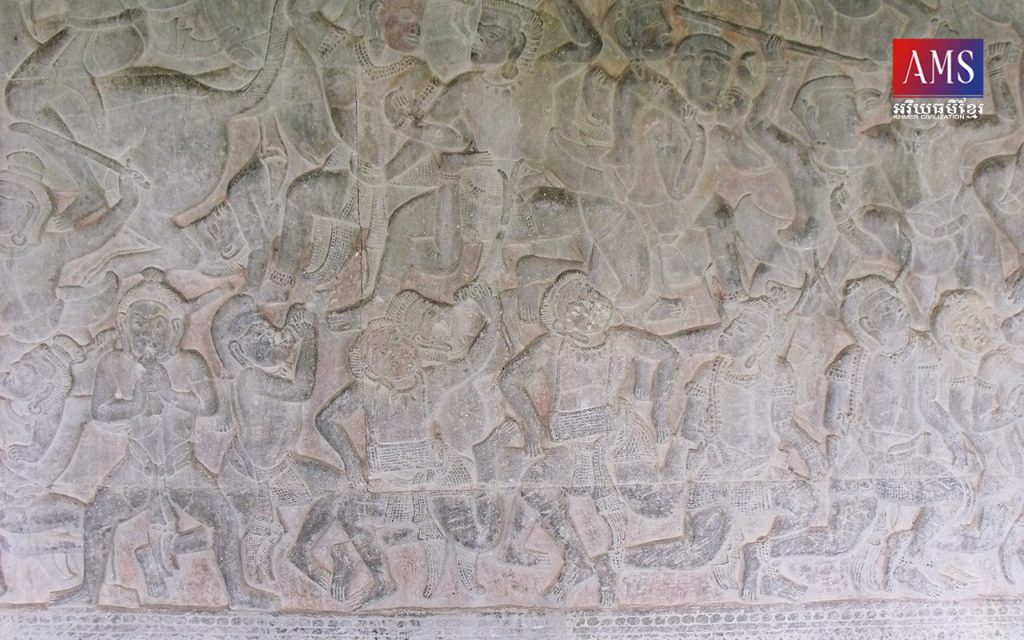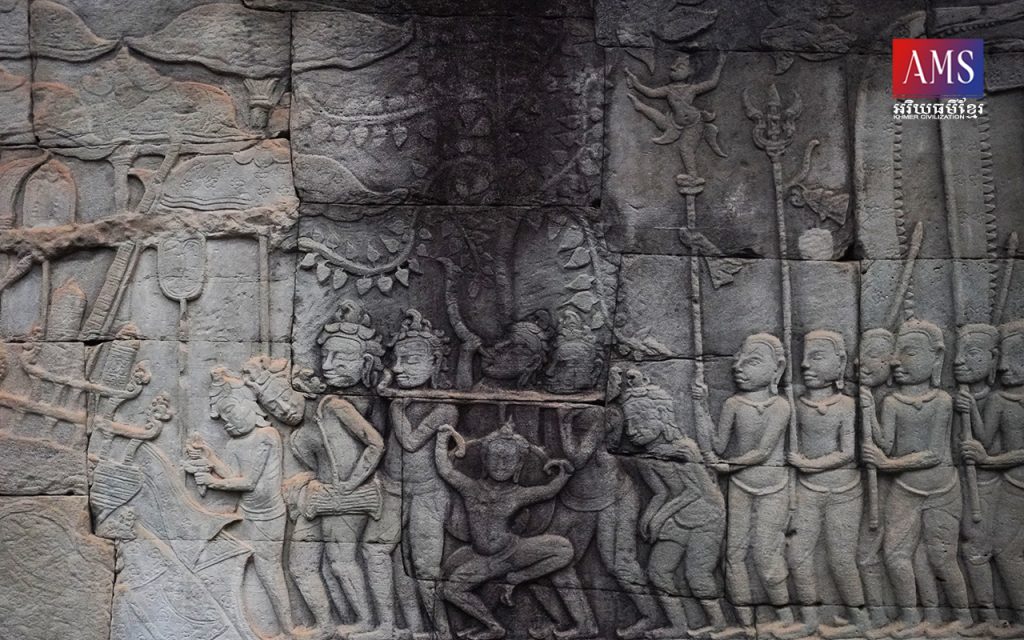នៅក្នុងអត្ថបទនេះ ខ្ញុំប្រើពាក្យ «ប្រាសាទអង្គរ» ដោយសំដៅទៅលើប្រាសាទបុរាណខ្មែរ នៅក្នុង «តំបន់អង្គរ» គឺមិនត្រឹមតែប្រាសាទអង្គរវត្តតែមួយប៉ុណ្ណោះទេ ដែលមានចម្លាក់និងរូបតំណាងពីឧបករណ៍តន្ត្រីស្គរខ្មែរជាច្រើនប្រភេទ។ ម្យ៉ាងទៀត ខ្ញុំមានគោលបំណងចង់បញ្ជាក់អំពីការមើលច្រឡំ ឬ ហៅច្រឡំ «ស្គរយោល» ថាជា «សម្ភោរ» ជាដើម ដោយសារតែស្គរទាំងពីរប្រភេទនេះ មានមុខពាសស្បែកពីរដូចគ្នា ហើយប្រើដៃពីរដើម្បីនឹងវាយដូចគ្នា។ នៅក្នុងចំណាត់ថ្នាក់តន្ត្រីអន្តរជាតិ (organology) ស្គរយោល ជាប្រភេទស្គរ (cylindrical drum) ដែលមានរាងស៊ីឡាំង ឯសម្ភោរ (barrel drum) មានរាងជាធុងប៉ោងធំនៅចំកណ្តាលតួស្គរ ដូច្នេះយើងមិនគួរច្រឡំឡើយ។

ខ្ញុំបានសរសេរនៅក្នុងអត្ថបទពាក់ព័ន្ធនឹងឧបករណ៍តន្ត្រីបុរាណខ្មែរ ដែលបុព្វបុរស ខ្មែរយើង លោកបានឆ្លាក់នៅលើជញ្ជាំងប្រាសាទអង្គរពីមុនរួចមកហើយ រួមមានឧបករណ៍តន្ត្រី ម៉ិម ពិណ ខ្សែ១ ស័ង្ខ ស្នែង ត្រែ ស្រឡៃ ខ្លុយ ពាទ្យ គងញី (គងដោះ) គងឈ្មោល (គងរាប) គងតូច គងធំ ឈឹង ឆាប ជួង កណ្តឹង ថូន ស្គរដៃ ស្គរយោល ស្គរភ្លោះ ស្គរឈ្នះ សាំងណា សម្ភោរ ស្គរធំ និងស្គរជ័យ។
នៅក្នុងអត្ថបទនេះ ខ្ញុំសូមលើកយកតែឧបករណ៍ស្គរមកអធិប្បាយតែប៉ុណ្ណោះរួមមាន ថូន ស្គរដៃ ស្គរយោល ស្គរឈ្នះ សម្ភោរ ស្គរធំ និងស្គរជ័យ។ គេចែកស្គរទាំងនេះជាបីប្រភេទគឺ៖ ១) ប្រភេទដែលមានរូបរាងជាថូឬកែវ (goblet drum) ២) ប្រភេទមានរាងស៊ីឡាំង (cylindrical drum) និង៣)ប្រភេទមានរាងជាធុងប៉ោងធំ នៅចំកណ្តាលតួស្គរ (barrel drum)។

តាមការពិនិត្យ ខ្ញុំឃើញថារូបភាព ចម្លាក់ និងរូបតំណាងខ្លះ ជារូបប្រាកដនិយម បកស្រាយពីសេចក្តីពិតនៃជីវិតនិងសកម្មភាពជាក់ស្តែង ឯខ្លះទៀត ជារូបនិមិត្តសញ្ញា ព្រោះគ្មានភាពជាក់ស្តែងឬប្រាកនិយម។ លើសពីនេះទៅទៀត ខ្ញុំក៏សូមធ្វើការកត់សម្គាល់ថា ជាពិសេសចម្លាក់និងរូបតំណាងនៅលើជញ្ជាំងប្រសាទអង្គវត្ត ថែវខាងជើង លាតត្រដាងបង្ហាញអំពីក្បួនព្យុហយាត្រាដែលមាន១៤ផែន ដូចដែលសិល្បករនិង សិល្បការិនីនៃក្រសួងវប្បធម៌និងវិចិត្រសិល្បៈធ្លាប់បានតម្លើងនិងសម្តែងទទួលលោកប្រធានាធិបតី ហាឡេសេឡាស្យេ នៃប្រទេសអេធីយូពី លោកស្សាល ដឺហ្គោល ប្រធានាធិបតីនៃសាធាណរដ្ឋបារាំង និងនៅពេលថ្មីៗនេះនៅក្នុងព្រឹត្តិការណ៍ «អង្គរឃ្យុងយូ» ដែលខ្លួនខ្ញុំផ្ទាល់បានធ្វើជាពិធីករ។ រូបភាពជាក្បួនព្យុហយាត្រា១៤ផែន តំណាងនិងលាតត្រដាងអំពីស្នាដៃដ៏មហិមានិងភាពជោគជ័យដ៏អស្ចារ្យរបស់ខ្មែរនាសម័យអង្គរដ៏រុងរឿង។

នៅក្នុងបរិបទនេះ ស្គរមុខពីរនិងសម្ភោរព្យួរនៅនឹងក គឺមិនខុសគ្នាពីព្យុហយាត្រានៅក្នុងព្រះបរមរាជវាំងនាពេលបច្ចុប្បន្ន ក្នុងព្រះរាជពិធីអភិសេក ព្រះរាជពិធីសព និងនៅទីលានវាលព្រះមេរុ ក្នុងព្រះរាជពិធីច្រត់ព្រះនង្គ័លជាដើម។ ដូច្នេះ ស្គរមួយចំនួននិងសម្ភោរព្យួរនៅកជាកត្តាបរិបទព្យុហយាត្រា៕
—————————————-
KHMER MEMBRANOPHONES ACCORDING TO THE ICONOGRAPHY OF ANGKOR TEMPLES
In the present article, I used the words “Angkor temples” to refer to the group of Khmer ancient temples in the Angkor vicinity, not just the Angkor Vatt temple, where Khmer membranophones in question are examined. On the off-set, several characteristics should be made clear, that is, there are three types of Khmer membranophones represented on the carving and iconography of Angkor. They are goblet drums: thaun and skor dai (skor dey), cylindrical drums: skor yol, skor phluoh, skor chhneah, Saingna, and barrel drums: sampho, kor thomm, skor chey.
It should be noted that organological speaking, Sampho (small double-headed barrel drum), for instance, is a barrel drum not a cylindrical one; it is a type of “floor drum” with stands, not “suspended drum.” It is suspended only during a procession (in the past); today, it would be put on a cart or a carrier when being used in the procession. By calling sampho, skor yol, for instance, or vice versa, callers/writers are confused between these two.
In my previous articles, I have separately alluded to the ancient Khmer musical instruments presented in the carvings of the Angkor temples, including memm, pinn, khsae muoy, saing, snaeng, trae, sralai, khloy, peat, korng nhi, korng chhmol, korng tauch, korng thomm, chhing, chhap, chuong, kandoeung, thaun, skor dai, skor yol, skor phluoh, skor chhneah, saingna, sampho, skor thomm, and skor chey. In this article, I shall touch upon only thaun, skor dai, skor yol, skor phluoh, skor chhneah, saingna, sampho, skor thomm, and skor chey.
By way of examination, we can see that the Angkor pictures, carvings, and iconographies are presented both realistically and unrealistically. The former reveals the livelihoods, events, and situations actually unfolding then, whereas the latter shows a 14-framed procession glorifying the opulence and greatness of the ancient Khmer of the Angkor period. These 14-framed processions have been mounted and show-cased several times in the past, including one in Phnom Penh when Cambodia received the then President Leul Ras Imru Haile Selassie of Ethiopia, in Siem Reap for President Charles de Gaulle of France, and the more recent Angkor Kjung Yu event. In this context, the suspended double-headed drums in the procession were not any different from the royal processions in Phnom Penh palace during the royal wedding and funeral or on the national ceremonial ground, Veal Preah Meru, during the Royal Ploughing Ceremony in which ensemble instruments are carried by men or transported by pulling carts.
អត្ថបទដើម៖ បណ្ឌិត សំ សំអាង






